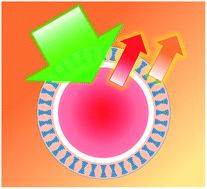Microfluidic generation of cholesteric liquid crystal droplets with an integrative cavity for dual-gain and controllable lasing†
Abstract
The integration of one more gain media in droplet microlasers with morphology-dependent modes, which can be employed in optofluidic systems as multi-wavelength lasing sources, is highly attractive and demands new cavity design and fabrication approaches. Here, cholesteric liquid crystal (CLC) droplets with an integrative triple-emulsion cavity are fabricated via glass-capillary-based microfluidic technologies and dual-gain lasing with variable modes, flexibly configured by the combination and incorporation of gain dyes and CLCs into both the core and shell. The distributed feedback (DFB) mode, formed by the feedback from the self-assembled helix periodic structure of CLCs, the whispering gallery (WG) mode, and the hybrid, is selectively excited by controlling the spatial coupling between the pump beam and the droplet with gain. With the merits of dual-gain and controllable lasing, a prototype dual-wavelength-ratiometric thermometer with self-calibration capability is expected to be developed. Furthermore, the anisotropic CLC core is substituted with an isotropic fluid and the gain from the CLC shell is additionally removed, DFB lasings in both shell and core are absent, and only Bragg-shell reflection-based hybrid modes are excited for lasing. The CLC droplet microlasers with an integrative cavity are expected to provide a new route to future lab-on-chip (LOC) applications.

- This article is part of the themed collection: In celebration of Chinese New Year 2020


 Please wait while we load your content...
Please wait while we load your content...